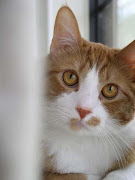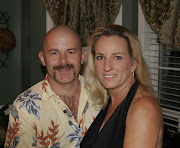
Right after that we had a Dolphin swimming next to us, which is a good sign. The weather was just as predicted if not even better. Now this is how sailing is supposed to be. We shut of Max, our trusty Westerbeke engine, and sailed at about 5-6 knots. Everything went as planned. As the sun set it got a little chilly and the wind and waves started to pick up. Even though it got a bit rougher, it was still not a bad sail. By now we had turned a little more to the east and the waves, which now reached 4-6 feet, hit us from the port. We were both pleasantly surprised on how well the boat took the waves. Nancy and I were feeling a little queasy, but other than that we were okay. Butters on the other hand was not too happy with us or anything at this point. He had already blessed every rug with puke and was lying under the bed. We had given him some paste that was supposed to help him relax, but I am not sure it worked too good. The wind now had reached 20 knots, gusting to 25, so we furled in the Jib and reefed down the main sail. Up to this point I always wondered why sailors say that they reef down for the night. I decided to reef the main after the weather got worse. Not a great idea. Nancy took me into the wind; I lowered the main, then tethered in and went forward to attach the main tack to the mast. Hmmmm, did I mention that I had nothing prepared for that. I took a rope from a bumper and used that to tie of the reef point to the mast. Then I tied down the excess sail. Hmmm, I guess having ties for that would have helped. I found another line of a bumper and used it. Now back to the cockpit to tighten up the main halyard. Hey, I had one of those. So after about 20 minutes being thrown back and forth and a few choice words, the reefing was done. Only 30+ hours to go, piece of cake! Nancy and I took 2 hour turns behind the autopilot. Of course in these kind of conditions neither one of us could sleep. So the two hour shifts were out. What it came down to is that we switched out more frequent and stayed behind the helm until we got tired. We kept checking the weather on our C-80, which was a life saver. The forecast had not changed. Still calling for 15-20 knots and 3-5 feet waves. That right there should have given us a clue. When NOAA reports 3-5 feet, just add 3+5 together and use that. That is what we are going to do from now on. By now we were in 20-25 knots and at least 8-10 foot waves. This all was a little scary, but not too bad as long as the engine holds up. My vacuum gage on the fuel filter was going towards the red line, and there was no way in hell that I could have gone down below in these conditions to change a filter. Luckily the engine held out just fine and never missed a beat. Thank you Max! The rest of the night was pretty event less, just very, very bumpy. At times I tried to turn more into the wind to limit our motion to the up and down vs. the up and down and all around. When I turned into the waves, we made about 2 knots over the ground. At that speed we would get there a little past never. Staying on course at least gave us 4-5 knots. The only good thing about the night was that we had a full moon which gave us plenty of light, even though sometimes I think it would have been better not to see what was about to hit us. When the sun came up in the morning we once again checked the forecast and yup, you guessed it, it changed. Now they are forecasting 15-20 knots, becoming 20-25 at night, with 4-6, building to 6-8 at night. My ass I was saying, we had 8-10 now with 25, gusting to 30. After we looked at the charts, we found that the closest shoreline was not only 30 miles away, but also 30 miles almost behind us. So we turned towards Government Cut, which would lead us into Apalachicola Bay. To make a long story a little shorter, we did just that, and after about 30 hours we ended up, totally pooped, in a nice little place called Scipio Creek Marina. If we would have gone there from Panama City, it would have taken us only 10 hours. Oh well. This was by far the roughest weather we have seen so far and we hope this will be the only time that we have to endure it. Never the less it did give us confidence in the boat’s handling capabilities and our sailing skills. I am going to close with a few lessons learned, and then Nancy is going to take back over and finish off.
1. The SR-50 Sirius Wx for the Raymarine was a lifesaver.
2. Reefing the Mainsail before the weather gets bad is a must.
3. If you plan on long trips, and you have the space, I would recommend installing a dual fuel filter system that will let you switch filters without having to shut down. I think I will get one of those too.
4. Hope for the best weather and conditions, but prepare for the worse.
5. The Gods don’t like Metaxa, so use something else.
6. Last but not least Nancy I love you!

 Above Dirk and I are enjoying our Turkey meal and below our bartender that we called Sara due to her resemblance to Mrs. Palin.
Above Dirk and I are enjoying our Turkey meal and below our bartender that we called Sara due to her resemblance to Mrs. Palin.
















